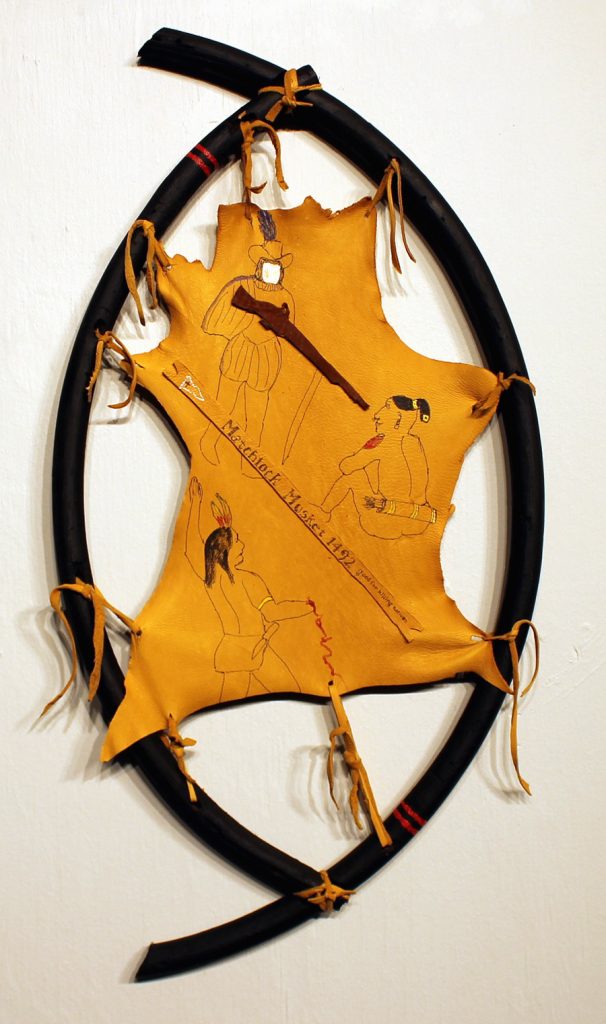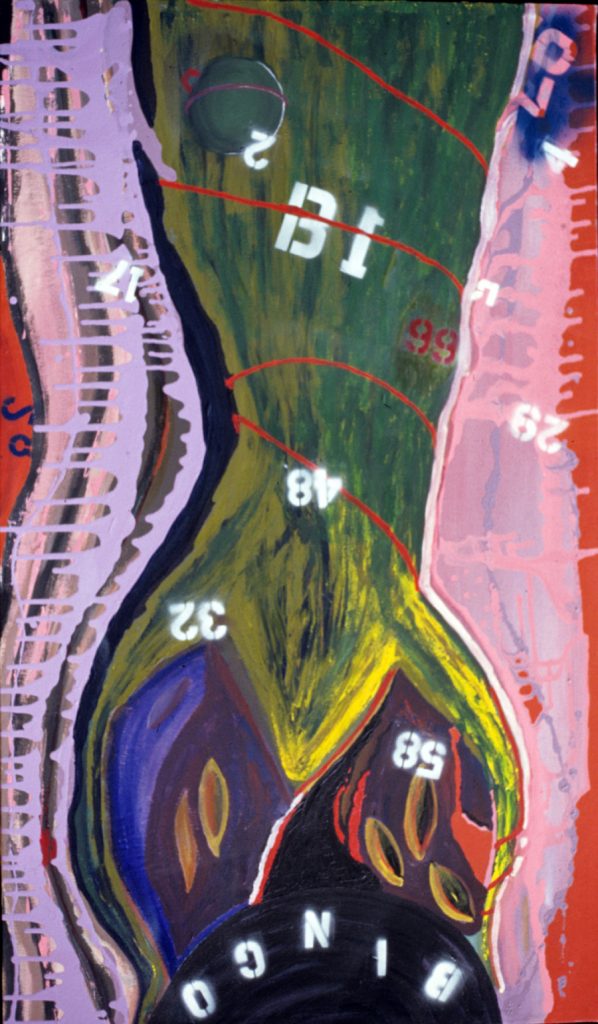The Dreamcatcher
By Derrick White
 “My experience with art started with Ms. Bobbin. I lived in a small, poor mining town. The school did not have an art program, but in the fifth grade, a roving art teacher was employed to conduct an art class for one hour a week for each grade. I remember being quite excited by this experience. We did soap carvings from large bars of soap. I carved a rabbit. It was great,” remembers local artist Ray Sikes.
“My experience with art started with Ms. Bobbin. I lived in a small, poor mining town. The school did not have an art program, but in the fifth grade, a roving art teacher was employed to conduct an art class for one hour a week for each grade. I remember being quite excited by this experience. We did soap carvings from large bars of soap. I carved a rabbit. It was great,” remembers local artist Ray Sikes.
While attending college, Ray Sikes became interested in theatre and scene design. At community college, Sikes took art classes because the teacher was a famous native artist. He later transferred to a university and continued to major in theatre. Afterward, Ray enrolled at Baylor University for a Master’s degree in Theatre in Scene and Lighting Design. After graduating from Baylor, Sikes started teaching set design and lighting at a community college in St. Louis, then moved to Washington D.C. and worked as an assistant to a noted sculptor. Afterward, he ended up in West Virginia where he became Managing Director for an art complex, but resigned and moved to Tyler so he and his wife, Linda, could care for her aging mother.
Ray recalls, “In Tyler, I played golf almost every day for two years. I became very bored. I told Linda I wanted to start taking some art classes. I had always wanted to just draw and paint full time, though I had been painting and drawing some during all my teaching years. I signed up for a life drawing class at the University of Texas at Tyler. Then I took a sculpture class. Karen Powell, the department chair at the time, told me if I were going to keep taking classes I should just earn a degree in painting. I told her I already had two degrees why would I need another, but she convinced me. Since I already had a Bachelors’ degree, it only took me about two years to complete a Bachelor of Fine Arts in painting and drawing.”
 During the time Ray was taking classes at UT Tyler, he was asked to start working for the department. Ray was the gallery director for the university’s Meadows Gallery. The Meadows Gallery is located within the R. Don Cowan Fine and Performing Arts Center on the campus of The University of Texas at Tyler and features rotating exhibitions throughout the year. The exhibition schedule includes nationally known guest artists, the Annual International Exhibition, faculty curated shows, Master of Fine Arts degree thesis exhibitions, and an annual student juried exhibition. The Annual International Exhibition is juried by an invited guest artist, historian or critic. The current 35th Annual International Exhibition is on view through March 6th, and was juried by independent curator Leslie Moody Castro. The Meadows Gallery will feature Jessica Sanders’ M.F.A. Thesis Exhibition March 16th-20th with a reception on March 17th. Nora Schreiber’s MFA Thesis Exhibition in the Meadows Gallery will run March 30th-April 3rd with a reception on March 31st.
During the time Ray was taking classes at UT Tyler, he was asked to start working for the department. Ray was the gallery director for the university’s Meadows Gallery. The Meadows Gallery is located within the R. Don Cowan Fine and Performing Arts Center on the campus of The University of Texas at Tyler and features rotating exhibitions throughout the year. The exhibition schedule includes nationally known guest artists, the Annual International Exhibition, faculty curated shows, Master of Fine Arts degree thesis exhibitions, and an annual student juried exhibition. The Annual International Exhibition is juried by an invited guest artist, historian or critic. The current 35th Annual International Exhibition is on view through March 6th, and was juried by independent curator Leslie Moody Castro. The Meadows Gallery will feature Jessica Sanders’ M.F.A. Thesis Exhibition March 16th-20th with a reception on March 17th. Nora Schreiber’s MFA Thesis Exhibition in the Meadows Gallery will run March 30th-April 3rd with a reception on March 31st.
“After my first few painting and drawing classes at UT Tyler, I realized I wanted to explore my native heritage through art. This started me on a research exploration about native aboriginals. This research led me to see most native arts had a spiritual/social conscience content. It just was not art for art’s sake; it had a societal purpose. I ask myself how this could be portrayed through my art. I came to use native forms like shields, deer skins, beads, and feathers. Plus, after visiting the Denver Art Museum and seeing original ledger paintings, I realized that the native style of painting was very flat and did not follow the western strictures of perspective. I have tried to paint in this way; although, there are times when I forget and revert to the Western canon. It is hard to forget how one was trained.”
 “One of my first shields was made from rose bush stalks tied with leather and stretched over with tanned deerskin. I painted the pictures on the shield with red clay from my yard. I then realized I did not want to take the time to find and process natural dyes, so now I paint with acrylic paint on tanned leather. I tried oil paint first, but it tends to bleed into the leather surrounding the object leaving an oil stain.”
“One of my first shields was made from rose bush stalks tied with leather and stretched over with tanned deerskin. I painted the pictures on the shield with red clay from my yard. I then realized I did not want to take the time to find and process natural dyes, so now I paint with acrylic paint on tanned leather. I tried oil paint first, but it tends to bleed into the leather surrounding the object leaving an oil stain.”
“I think calmness is a gift from my art. When I am in my studio and working on some piece, I am in the ‘flow’ much of the time. There was one noted artist who said, ‘When I go into my studio all my friends are there in my mind, then after a while, it is just me, then I leave and my work of making an art piece begins.’ I start to work on a certain piece and when I look up four hours have passed on the clock and I am calm.”
“Waiting so long to do what I really wanted to do – just paint! I think this happened because I listened to a very significant person in my life long ago that pushed their agenda on me and I believed them. I learned much later one needs to ‘follow your bliss’ and to hell with what other people say about what you want to do.”
“The first one is Henri de Toulouse-Lautrec, a 19th-century post-impressionism painter, who recorded many details of the late-19th-century bohemian lifestyle in Paris. Lautrec mastered many visual art forms: printmaking, drawing, painting, caricaturist, and illustrator. Because of his title and disability, he was accepted into many levels of society, but he chose mostly to paint from the lower classes. He especially liked the people of dance halls and brothels. I find his work honest and clearly stated.”
“Fritz Scholder is a native 20th-century artist, who mostly paints natives. His ‘most influential works were post-modern insensibility and somewhat pop art in execution as he sought to deconstruct the mythos of the American native.’ Fritz was a Luiseno native, part of the California Mission culture. I like his work because it pushes the edge of work by natives about natives. Since a lot of my work is about natives on this continent, he gives me inspiration and insight into what I think about what I want to paint.”

















